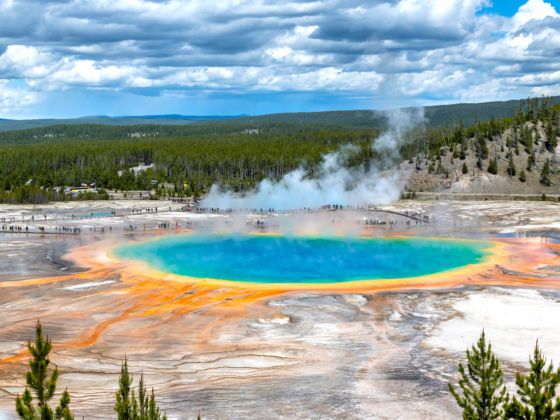AMERICA’S NATIONAL PARK SERVICE celebrated its 100th anniversary in August, which gives us a great opportunity to reflect on the agency’s first century of stewardship and the accomplishments achieved along the way. Today, the NPS protects 413 park units across more than 84 million acres of public lands and waters; last year, these parks attracted more than 307 million visitors.
Clearly, Americans value their collective backyard, but the parks also face significant challenges as the NPS mission enters its second century. Some of the most pressing are presented below, along with suggestions for how you can help.
1. The human impact
It could be seen as a bit of a paradox: We want our national parks to be appreciated, to be popular destinations for vacationers and explorers — in short, to be enjoyed by the people for whom they’re being preserved (all of us). But there are serious consequences to increased visitation of the parks. More people in these lands means more traffic, a greater risk of habitat damage, and a lot more waste generated.
The National Park Service managed more than 100 million pounds of visitor-generated waste in 2013. That’s nearly the equivalent weight of ten Fort Knoxes worth of gold! On this point, thankfully, private-industry partners are stepping up. Subaru is the nation’s first zero-landfill automaker, and last summer it partnered with the National Park Conservation Association and the National Park Foundation to consult on solutions to the significant trash-accumulation issues experienced by many parks.
Together, Subaru and its park partners are testing proven practices in Yosemite, Grand Teton, and Denali National Parks with the goal of significantly reducing landfill-bound waste in all of the country’s parks. And they need your help. By following some simple suggestions before, during, and after your visit to a national park, you can dramatically minimize your waste impact. Check out Subaru’s site to learn how you can help our parks reach zero-landfill status.
2. Budget shortfalls
It’s not the most headline-gripping topic, but insufficient funding lies at the core of many issues the National Park Service faces. In February of this year, NPS reported a FY15 deferred maintenance backlog of $11.93 billion, which represents critical facility repairs and updates the agency has been forced to put off due to lack of funding. Our park system encompasses more than 70,000 individual facility assets — visitor centers, bridges, trails, etc. — and virtually every park has projects that have been delayed. Along the Blue Ridge Parkway alone, 2015 statistics calculate more than $516.6 million in deferred maintenance for the park’s 3,000 asset locations, many of which haven’t been updated in more than 80 years.
As with many government-managed and -funded projects, political gridlock can tie the hands of willing park staff, contractors, and volunteers. Most frustratingly, programs already in place to help park operations and land purchases have been weakened or ignored, forcing NPS to go without promised funds time and time again. For example, Congress passed the Land and Water Conservation Fund Act in 1964, which directs a portion of revenues generated from offshore oil and gas projects to support public lands and waters for all Americans to enjoy. Every year, energy companies drilling offshore are to add $900 million to this fund, earmarked for national, state, and local park programs and acquisitions across the country. However, Congress reallocates huge portions of this fund toward unrelated programs each year, leaving public lands hanging. The fund peaked at $369 million in 1979 and bottomed out at $0 in 1982 and 1996-1999.
Last September, political jockeying allowed the fund to expire for the first time in its 50-year history. Fortunately, Congress reauthorized a spending bill in December that gave the program a three-year lifeline, but even this only allocates half of the promised funds to public lands. The bill is up to eventually become permanent — it passed in the Senate but needs a green light from the House. To show your support for this bill, contact your representative.
3. Biological threats
While globalization has helped citizens of planet Earth in many ways, it has also created serious consequences for plants and animals in our parks and backyards. Cargo ships unintentionally transport invasive species from foreign shores (which devastate native populations), and the spread of disease cripples other unprepared species. In the eastern US, white-nose syndrome has killed roughly 6 million bats over the past 10 years, and it has spread to nearly all eastern states and Canadian provinces.
Climate change also contributes to — and results from — biological threats within the parks. In Glacier National Park in Montana, for example, the 150 robust glaciers that existed in 1850 have been reduced to just 25, and the ones that remain are shrunken versions of their former selves. Scientists predict all of these glaciers will disappear by 2030 if the current rate of climate-change-induced warming continues. Meanwhile, in Great Smoky Mountains National Park, clouds enveloping some high-elevation forests have pH levels on par with lemon juice, and acidified water kills entire fish populations once it makes its way into mountain streams. Similar problems abound in parks across the country. The hemlock wooly adelgid, an insect native to east Asia, has killed 95% of Shenandoah’s hemlock trees since 1988. It can’t tolerate deep freezes, but the park’s recent series of mild winters has allowed more insects to survive. A 2009 study by the US Forest Service found that the accelerated pace with which this insect kills trees in southern Appalachia rapidly alters carbon cycles of the damaged forests, reducing their ability to absorb atmospheric carbon.
While many biological and climate threats are difficult to influence at the individual level, there’s one easy way you can pitch in. If you’re camping and planning to have a fire, remember this when it comes to firewood: Buy it where you burn it. Bringing in wood from other regions means you’re also transporting whatever potentially harmful insects and parasites are living within that wood.
4. Staying relevant
Fifty years ago, kids spent their free time playing outdoors and easily developed a connection with and appreciation for nature. Today, technology threatens to monopolize their attention. A life spent indoors in front of a screen doesn’t foster a conservation ethic, making it harder for a person to understand the negative impacts of human activity on the environment. Adults experience this disconnect as well, and this apathy leads to parks getting passed over, when it comes to both federal funding and family vacations. The National Park Service’s stated goal for its Centennial this year is to “connect with and create the next generation of park visitors, supporters, and advocates,” and clearly this has never been more critical.
But again, you can help. First and foremost, go to the parks, and bring the kids in your life to help them discover the wonder of the natural world at a young an age. While you’re there, make an effort to reduce your impact by following Leave No Trace and Tread Lightly principles. Learn about different issues affecting the parks and write to your Congressperson so they know their constituents prioritize public lands. Sign pro-park petitions drafted by the National Parks Conservation Association and the National Park Foundation, and support these organizations and other partner groups with your wallet. Look up volunteer opportunities at parks in your area and consider pitching in.
America’s public-lands birthright is one of its greatest gifts to its citizens. To protect and preserve the parks for future generations, we must take action today. Your efforts can make a difference.

